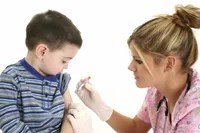Perhaps the 20th century’s greatest public health accomplishment was the widespread use of vaccines to limit the spread of disease. In the mid-1950s, national efforts started promoting vaccine for all children in the United States. Since then, deaths associated with smallpox and polio caused by wild-type viruses have been eliminated. The death rate is nearly zero for other diseases with vaccines, such as measles and tetanus.

However, just because a disease is virtually eradicated in the United States does not mean it can’t be brought here from other parts of the world. It is for this reason that the continued immunization of children in this country is so important. Without regular vaccinations, an epidemic could occur, causing thousands of unnecessary deaths. Vaccinations are safe, and adverse reactions are rare. The benefits of immunization to individuals and society far outweigh these limited risks.
A vaccine works by injecting low levels of a dead or weakened virus into the body. The body’s immune system then creates antibodies to fight the disease. Once the body has the code to kill the virus, it will release the antibodies when it comes in contact with the disease again, thus preventing infection.
The Centers for Disease Control and Prevention (CDC) recommend all children receive vaccinations against these diseases:
—Hepatitis B
—Diphtheria
—Tetanus
—Pertussis (whooping cough)
—Haemophilus influenzae type b (Hib disease)
—Polio
—Pneumococcal disease
—Measles
—Mumps
—Rubella
—Varicella (chicken pox)
Specific circumstances may warrant additional vaccinations. Although children should be inoculated against multiple diseases, some of the vaccinations are given in one shot, reducing the number of total injections needed over a lifetime. Children must receive each vaccine at specific ages for maximum effectiveness:
—Hepatitis B: between birth and 2 months, between 1 month and 4 months, and between 6 months and 18 months.
—Diphtheria, tetanus and pertussis: 2 months, 4 months, 6 months, between 15 months and 18 months, and between 4 and 6 years. At 11 years, the booster for tetanus and diptheria toxoids is given and should be updated every 10 years.
—Hib disease and pneumococcal conjugate (each): 2 months, 4 months, 6 months, and between 12 and 15 months.
—Inactivated polio vaccine: 2 months, 4 months, between 6 and 18 months, and 6 years.
—Measles, mumps and rubella: between 12 and 15 months, and between 4 years and 6 years. The second injection should be given by 12 years if missed earlier.
—Varicella: between 12 months and 18 months.
—Hepatitis A (only for those who live in an area where it is prevalent or if part of a population group at high risk): between 24 months and 18 years.
Your pediatrician will keep careful records and remind you when the next series of immunizations is needed. For further information regarding immunization, ask your doctor, visit the CDC Web site, www.cdc.gov, or call the National Immunization Information Hotline at 1-800-232-2522 (English) or 1-800-232-0233 (Spanish).
DR. NARULA is chairman of pediatrics, NY Methodist Hospital, Brooklyn.





















